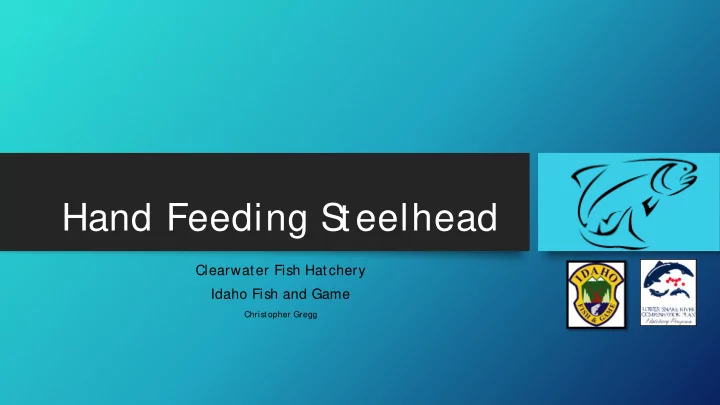

Hand Feeding S teelhead Clearwater Fish Hatchery Idaho Fish and Game Christ opher Gregg
Table of Contents • Facility • Production • Challenges • Historic Procedures • Changes • Observations • Results
Clearwater Fish Hatchery Facility • Water supply 73 CFS for production Temperature range 40° F to 56° F • Rearing 60 concrete early rearing vats 46 concrete final rearing raceways
S teelhead Production Goals • S ize at release 4.5 fish per pound (fpp) • 843,000 release inventory • Ten month rearing cycle Initial ponding to release
Fish Culture Rearing Challenges • Automatic bridge feeders Present feed inefficiently in final rearing 62% of steelhead growth occurs during final rearing • Water temperature Average maximum temperature allowed - 56° F S teelhead achieve maximum growth rates at slightly warmer temperatures 59° F - 64° F
Historic Feeding Procedures Early Rearing • Hand feeding – Initial feed through #0 crum Feeding frequency – 8 to 10 times per day • Automatic feeding - #1 crum through 1.2mm pellet Feeding frequency – 10 to 15 times per day
Historic Feeding Procedures Final Rearing • Hand feeding – 1.2mm through 1.5mm pellet Feeding frequency – 6 to 8 times per day • Automatic feeders (bridge) – 2.0mm through 2.5mm pellet Feeding frequency – 6 to 8 times per day Maximum pellet size 2.5mm
Fish Culture Changes Early Rearing • Hand feeding – Initial feed only Feeding frequency 8 to 10 times per day • Automatic feeding - #0 crum through 1.2mm pellet Feeding frequency – 25 to 30 times per day Approximately every 30 minutes for 15 hours a day
Fish Culture Changes Final Rearing • Hand feeding – 1.2mm through 3.0mm Feeding frequency – Decreased as fish size increased 120 to 51 fpp – 4 to 5 times per day 50 to 31 fpp – 2 to 3 times per day 30 to 15 fpp – 1 to 2 times per day > 15 fpp – one feeding per day
Observations Fish Culture • Feed conversion rates (FCR) are similar to historic rates or slightly better BY15 year to date FCR - .79 • More active/ aggressive fish at feeding • S weeping raceways is easier, and quicker than in past years • Improved fin quality
Conclusions • Will meet our 4.5fpp release goal • Time spent performing fish culture is a wash More time spent feeding fish Less time spent sweeping • Provided an avenue to teach new employees Proper feeding techniques Perfect practice makes perfect performance S pecies/ Temperature awareness All species have optimum temperature ranges where maximum growth can be achieved Responsible fish culture (most important) Good instruction + Positive attitude = Well fed fish + Clean raceways Happy & Healthy fish
Recommend
More recommend